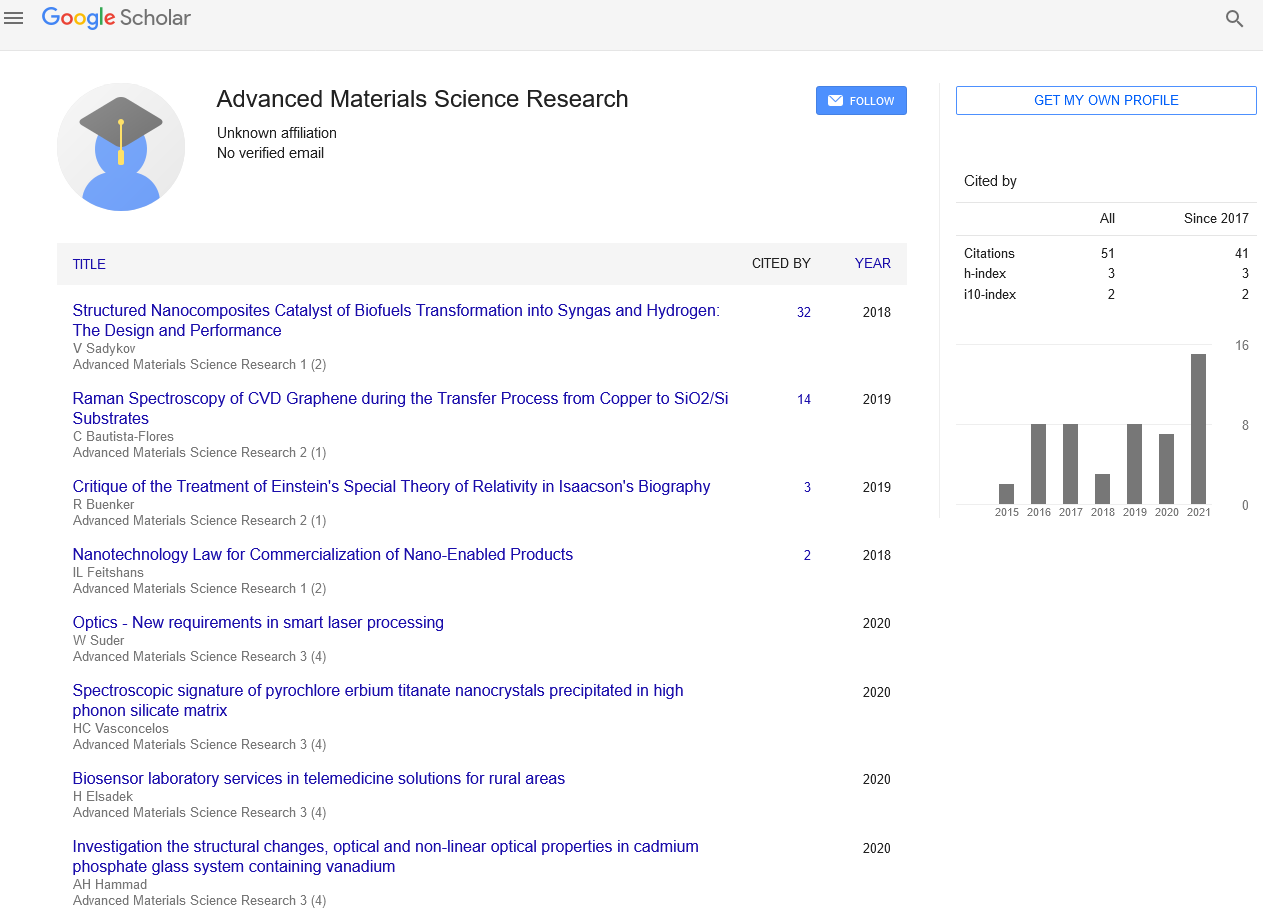Editorial - Advanced Materials Science Research (2023) Volume 6, Issue 4
Exploring the World of Functional Materials Revolutionizing Technology and Beyond
Fezu Tiwari*
Department of Materials and Structures, NASA Glenn Research Center, USA
Department of Materials and Structures, NASA Glenn Research Center, USA
E-mail: Tfezu3@gmail.com
Received: 01-Aug-2023, Manuscript No. AAAMSR-23-108054; Editor assigned: 03-Aug-2023, Pre-QC No. AAAMSR-23-108054 (PQ); Reviewed: 17-Aug-2023, QC No. AAAMSR-23-108054; Revised: 22-Aug-2023, Manuscript No. AAAMSR-23-108054 (R); Published: 29-Aug-2023; DOI: 10.37532/ aaasmr.2023.6(4).58-60 Mini Review
Abstract
Functional materials play a pivotal role in shaping the landscape of modern technology and driving advancements across various sectors. These materials possess unique properties and functionalities that enable the development of innovative devices, systems, and applications. This abstract provides an overview of functional materials, highlighting their diverse range of properties, synthesis methods, and applications across multiple fields. Functional materials exhibit specific physical, chemical, electrical, or mechanical properties that can be tailored and optimized to meet specific requirements. They can be engineered to possess exceptional conductivity, magnetism, thermal stability, optical transparency, or biocompatibility, among other characteristics. The controlled manipulation of these properties empowers scientists and engineers to design materials with desired functionalities, such as energy conversion and storage, sensing, actuation, and information processing. The synthesis and fabrication of functional materials involve a variety of techniques, including chemical synthesis, nanofabrication, self-assembly, and additive manufacturing. These methods enable the precise control of material composition, structure, and morphology at the nanoscale, resulting in enhanced performance and novel functionalities. Furthermore, advances in materials science and engineering have led to the development of multifunctional materials that combine multiple properties to achieve synergistic effects, fostering innovation and expanding application possibilities. The application areas of functional materials span diverse sectors, including energy, electronics, healthcare, environment, and transportation. In the field of energy, functional materials are critical for efficient solar cells, high-capacity batteries and catalysts for clean energy conversion. In electronics, they enable the miniaturization and improved performance of electronic devices, including flexible displays, wearable electronics, and high-speed transistors. In healthcare, functional materials are employed in drug delivery systems, tissue engineering scaffolds, and biosensors for diagnostics. Moreover, functional materials contribute to environmental sustainability through applications in pollution remediation, water purification, and renewable resource utilization. In transportation, lightweight and high-strength functional materials enhance fuel efficiency and safety in automobiles, aircraft, and infrastructure.
Keywords
Functional Materials • Energy • Automobiles • Solar cells • Tissue engineering scaffolds
Introduction
Functional materials have emerged as a cutting-edge field of research and development, revolutionizing various industries and pushing the boundaries of technology. These materials possess unique properties that enable them to perform specific functions beyond their basic physical and chemical attributes. From enhancing energy storage and generation to enabling flexible electronics and biomedical advancements, functional materials are at the forefront of scientific and technological progress. This article delves into the exciting world of functional materials, exploring their characteristics, applications, and potential future prospects [1]. The continued advancement of functional materials holds great promise for addressing societal challenges and shaping a sustainable future. As research and development in this field progress, the synthesis of functional materials with improved performance, durability, and environmental compatibility is expected. Moreover, the integration of functional materials into next-generation technologies, such as artificial intelligence, Internet of Things, and quantum computing, will unlock new possibilities and revolutionize various industries [2].
Understanding functional materials
Functional materials refer to a class of substances engineered to possess specific properties that enable them to perform specialized functions. These materials often exhibit remarkable physical, chemical, electrical, or mechanical properties that go beyond what conventional materials can offer [3]. Scientists and engineers manipulate the atomic and molecular structure of these materials to enhance their performance and create desired functionalities.
Types and properties of functional materials
Functional materials encompass a wide range of substances, each tailored for a specific purpose. Some notable examples include,
Superconductors: These materials exhibit zero electrical resistance at low temperatures, enabling efficient electricity transmission and magnetic levitation systems [4].
Piezoelectric materials: These substances generate electric charges when subjected to mechanical stress, finding applications in sensors, actuators, and energy harvesting devices.
Ferroelectrics: These materials possess spontaneous electric polarization, making them ideal for memory storage, capacitors, and electrooptic applications [5].
Photovoltaic materials: Also known as solar cells, these materials convert light energy into electricity, facilitating sustainable energy generation.
Shape memory alloys: These materials can return to their original shape after being deformed, making them valuable in biomedical devices, robotics, and aerospace applications.
Biomaterials: Designed for compatibility with biological systems, biomaterials are used in tissue engineering, drug delivery, and implantable medical devices.
Applications and impact
Functional materials have had a significant impact on various industries, transforming technology and enhancing everyday life. Some notable applications include:
Electronics: Functional materials enable the development of smaller, faster, and more efficient electronic devices. They are used in flexible displays, wearable electronics, and high-performance transistors, enabling the next generation of consumer electronics [6].
Energy storage and generation: Functional materials play a vital role in advancing energy storage technologies, such as lithium-ion batteries and super capacitors. They also contribute to renewable energy generation, as seen in solar panels and fuel cells.
Healthcare and biomedicine: Biomaterials have revolutionized medical treatments, including tissue engineering, drug delivery systems, and implantable devices. Functional materials are also crucial in medical diagnostics, biosensors, and bio imaging techniques [7].
Environmental applications: Functional materials are being utilized for environmental remediation, pollution sensing, and water purification. They contribute to sustainable development by improving resource efficiency and minimizing environmental impact.
Future prospects
The field of functional materials continues to evolve, presenting exciting opportunities for future advancements. Here are a few potential areas of development.
Smart materials: Functional materials with adaptive and responsive properties could revolutionize various industries. These materials can change their physical or chemical properties in response to external stimuli, enabling advanced applications in robotics, aerospace, and intelligent systems [8].
Nanotechnology: Advances in nanomaterials and nanotechnology have opened up new possibilities in functional materials. Nanostructured materials exhibit unique properties due to their size-dependent characteristics, promising breakthroughs in areas such as energy storage, catalysis, and sensors [9].
Biocompatible materials: The development of functional materials that seamlessly integrate with the human body holds immense potential for healthcare. Biocompatible materials can improve prosthetics, enhance drug delivery systems, and enable advanced biointerfaces for neural interfaces and bioelectronics [10].
Conclusion
Functional materials have become an integral part of modern technology, transforming industries and driving innovation. Their exceptional properties and tailored functionalities have paved the way for groundbreaking developments in electronics, energy storage, healthcare, and environmental applications. As research and development in this field continue to flourish, functional materials hold the key to solving some of society's most press ng challenges and unlocking a future where technology seamlessly integrates with our daily lives.
References
- Ghomi R, Nourbakhsh N, Kenari MA et al. Collagen‐based biomaterials for biomedical applications.JBiomedMaterResPart BAppl Biomater J. 12, 1986-1999(2021).
- Zhou W, Qiao Z, Huang J et al. 4D-Printed Dynamic Materials in Biomedical Applications: Chemistry, Challenges, and Their Future Perspectives in the Clinical Sector. J Med Chem. 63, 8003–8024(2020).
- Spiegel CA, Hippler M, Münchinger A et al. 4D Printing at the Microscale. Adv Funct Mater.2019, 30, 1907615
- Ziheng L. Computational discovery of energy materials in the era of big data and machine learning: a critical review. Materials Reports Energy.1, 100047(2021).
- Saraswat S, Yadava GS. An overview on reliability, availability, maintainability and supportability (RAMS) engineering. Int J Qual Reliab Manag. 25, 330–344(2008).
- Ratnamani MPC, Zhang X, Wang H. A Comprehensive Assessment on the Pivotal Role of Hydrogels in Scaffold-Based Bioprinting. Gels .8, 239(2022).
- Pugliese H, Raffaele S, Regondi S. Artificial intelligence-empowered 3D and 4D printing technologies toward smarter biomedical materials and approaches.Polymers.14, 2794(2022).
- Leszek A, Danikiewicz D, Lech B et al. Effect of biomedical materials in the implementation of a long and healthy life policy.Processes9, 865(2021).
- Francis K. Biological evaluation of preceramic organosilicon polymers for various healthcare and biomedical engineering applications: A review.J Biomed Mater Res - B Appl Biomater.109,744-764(2021).
- Yiwei L, Liu BF, Zhang X. Wettability-patterned microchip for emerging biomedical materials and technologies.Mater Today. 51, 273-293(2021).
Indexed at, Google Scholar, Crossref
Indexed at, Google Scholar, Crossref
Indexed at, Google Scholar, Crossref
Indexed at, Google Scholar, Crossref
Indexed at, Google Scholar, Crossref
Indexed at, Google Scholar, Crossref
Indexed at, Google Scholar, Crossref
Indexed at, Google Scholar, Crossref
Indexed at, Google Scholar, Crossref

